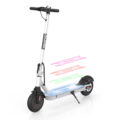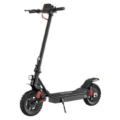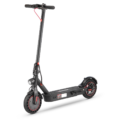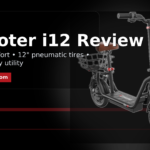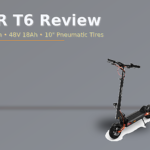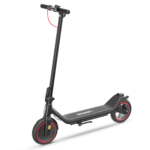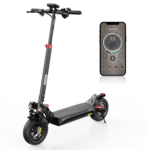- Home
- Scooters
- Electric Scooters
- iScooter F3
iScooter F3
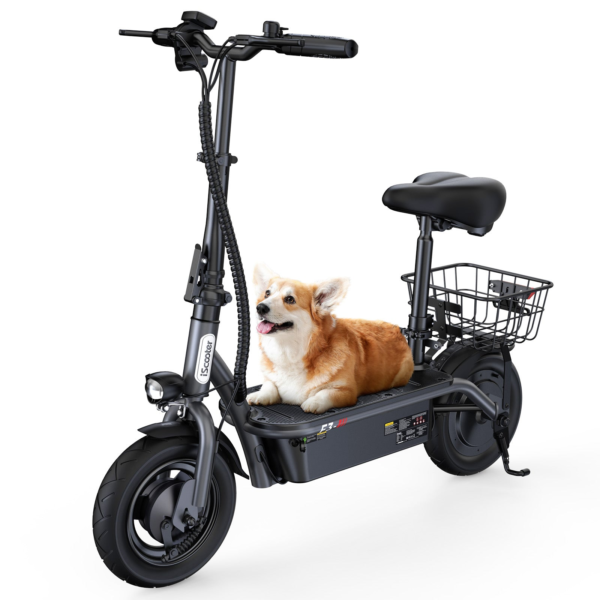

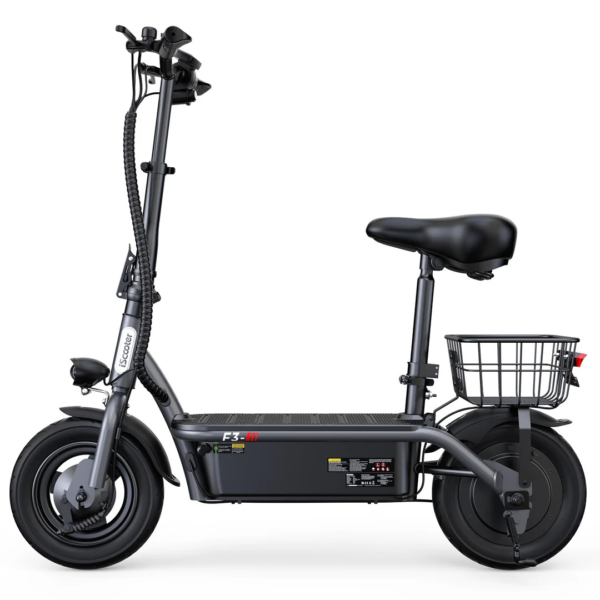

- Battery Range: 37 miles (55–60 km)
- Top Speed: 28 mph (45 km/h)
- Motor Power: 1000 W rear hub
- Weight Capacity: 264 lb (120 kg)
- Charging Time: ~5–6 h
- Scooter Weight: 43 lb (19.5 kg)
PROS
- 1000 W motor for stronger hills
- Dual disc brakes confidence
- 10″ pneumatic tires
- Foldable frame with basket option
- Good balance of weight and range
CONS
- No suspension listed in specs
- Air tires need pressure checks
- Range varies with speed/temp
- IP rating not listed

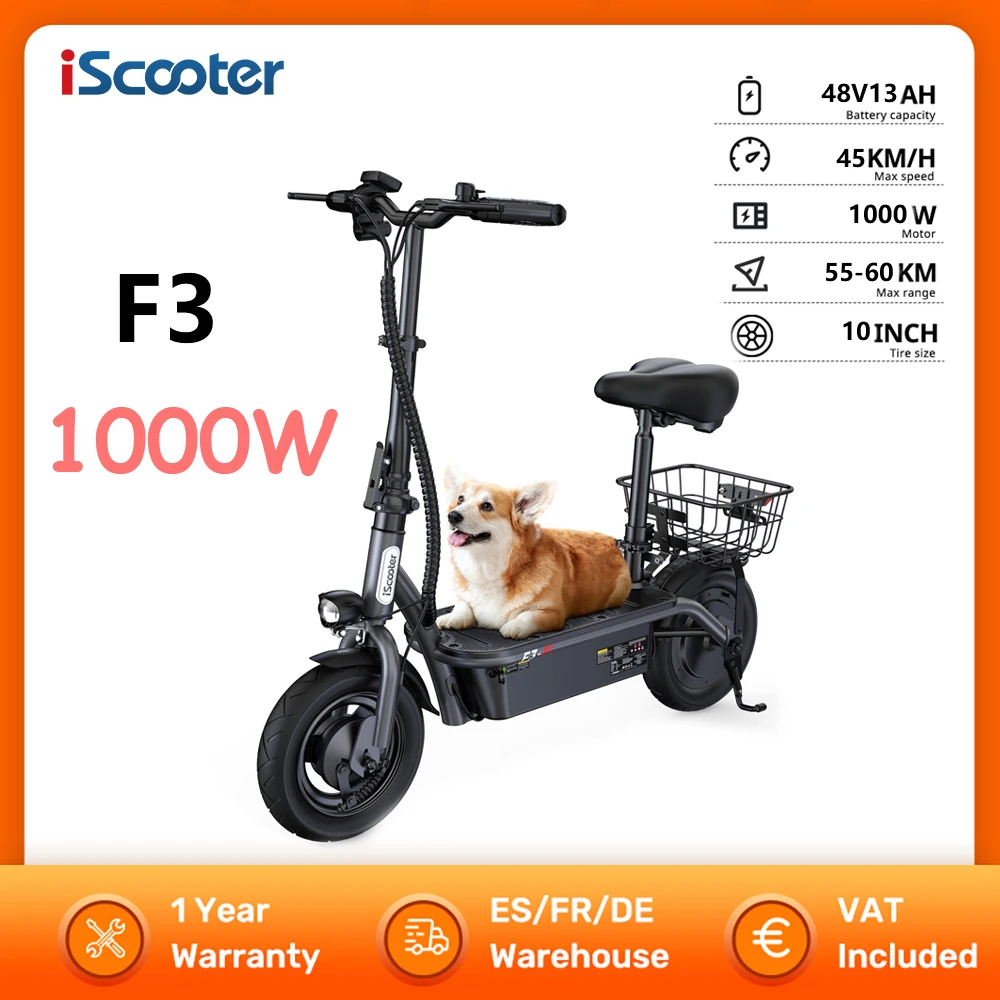

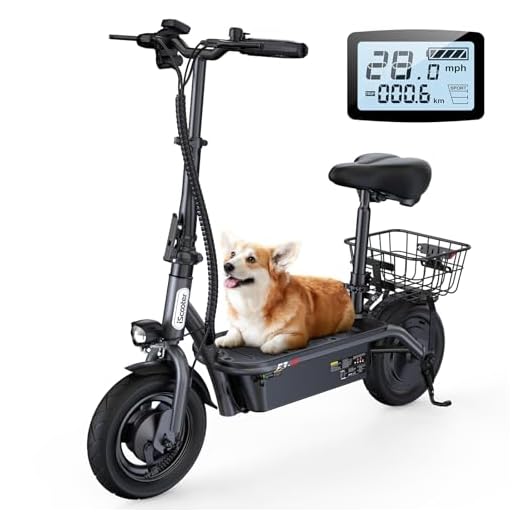
Table of contents
- What Is the iScooter F3?
- How the iScooter F3 Works
- Key Specifications
- Design & Build Quality
- Performance Fundamentals
- Battery, Range & Efficiency
- Ride Quality & Comfort
- Braking & Safety Features
- Portability & Daily Usability
- Maintenance & Care
- Weather & Seasonal Considerations
- iScooter F3 vs Alternatives
- Who the iScooter F3 Is (and Isn’t) For
- FAQs
- Glossary
- Final Notes on Use and Fit
The iScooter F3 is a seated, basket-equipped electric scooter built for practical city errands and short commutes. It pairs a 1000 W rear-hub motor with a 48 V, 13 Ah battery, 10-inch pneumatic tires, and dual mechanical disc brakes. Because it folds quickly and weighs about 43 lb (19.5 kg), it suits riders who prefer stable handling over raw speed. If you’re cross-shopping seated options, check the JOYOR F3 as a reference point for features and layout.
What Is the iScooter F3?
The iScooter F3 is a compact, utility-first scooter with a built-in seat and a detachable rear basket. It emphasizes predictable acceleration, simple controls, and a relaxed upright position. As a result, it works well for grocery runs, campus moves, neighborhood errands, or daily rides across flat to rolling streets. It has three speed modes (Eco/Tour/Sport), a claimed top speed around 28 mph (45 km/h), and a stated maximum range up to 37 miles (55–60 km) under ideal conditions. Moreover, it’s configured as rear-wheel drive, which helps traction when starting, especially on mild grades.
How the iScooter F3 Works
Although the F3 looks like a small moped, its drivetrain is pure e-scooter. Here’s the system in everyday terms:
- Motor: A 1000 W brushless hub motor is integrated into the rear wheel. Think of it as a compact, low-maintenance “engine” sealed inside the wheel. Because there are no chains or belts, it runs quietly and needs minimal upkeep.
- Controller: The controller is the F3’s “brain.” It meters battery power to the motor and enforces the three speed modes. When you change modes, the controller adjusts current and speed limits to match your choice of efficiency or pace.
- Battery: A 48 V, 13 Ah lithium-ion pack sits under the deck. Multiply volts by amp-hours and you get about 624 Wh of energy—enough for local commuting and repeatable short trips when ridden sensibly.
- Throttle: A thumb or trigger throttle (depending on market batch) sends a simple request: “go a little” or “go a lot.” The controller translates that into smooth acceleration. Because the power curve is gentle in Eco and Tour, new riders usually feel in control within minutes.
- Brakes: Front and rear mechanical disc brakes give consistent, cable-driven stopping power. You pull the levers, pads clamp the rotors, and speed drops predictably. Moreover, separate front and rear actuation lets you modulate grip on wet pavement.
- Lights & Display: A front white light and a rear red light support dusk riding, while the bar-mounted display shows speed, battery level, trip/odo, and mode. Consequently, you can monitor remaining charge and manage pace without guesswork.
Key Specifications
Units listed with U.S. values first, followed by metric in parentheses.
| Block | Item | Value |
|---|---|---|
| General | Model | iScooter F3 |
| Drive | Rear-wheel hub motor | |
| Top Speed | Up to 28 mph (45 km/h) | |
| Claimed Range | Up to 37 miles (55–60 km) | |
| Speed Modes | Eco / Tour / Sport | |
| Max Slope | 25% (≈14°) | |
| Rider Age (guidance) | 14+ | |
| Performance & Power | Motor | 1000 W brushless hub |
| Controller | Multi-mode, current-limited | |
| Drive Feel | Smooth launch; stronger mid-pull in Sport | |
| Battery, Charging & Electrical | Battery | 48 V, 13 Ah (≈624 Wh) |
| Charger | 54.6 V, 2 A | |
| Stated Charge Time | 5–6 hours | |
| Lights | Front white headlight; rear red tail/brake light | |
| Build & Dimensions | Tires | 10-inch pneumatic (air-filled) |
| Frame | Alloy frame with integrated seat post | |
| Weight | 43 lb (19.5 kg) | |
| Dimensions (L×W×H) | 40.6 × 21.9 × 37.4 in (1030 × 555 × 950 mm) | |
| Folded Dimensions (L×W×H) | 40.6 × 21.9 × 24.0 in (1030 × 555 × 610 mm) | |
| Safety & Control | Brakes | Dual mechanical disc (front & rear) |
| Reflectors | Rear basket light and rear reflector (varies by batch) | |
| IP Rating | Not specified | |
| Features & Extras | Seat | Included, height-adjustable |
| Basket | Detachable rear basket | |
| Cruise Control | Not specified | |
| Kickstand | Side-mount | |
| Warranty & Compliance | Warranty | 12-month limited warranty (manufacturer) |
| Regional Compliance | Varies by country/state; follow local laws |
Note: Manufacturer values are lab estimates. Real-world results depend on rider weight, terrain, temperature, and speed.
Design & Build Quality
The iScooter F3’s frame prioritizes utility. The deck is wide and flat, so your feet have room to rest side-by-side or staggered. Because the battery lives inside the deck, the center of mass stays low, which calms the steering at neighborhood speeds. The integrated seat post locks with a quick-release collar, and the basket mounts above the rear fender. As a result, small loads—like groceries or a backpack—sit securely without affecting balance.
The stem is height-adjustable and uses a clamp collar. After you set bar height, close the lever firmly and check for any play by rocking the bars front to back. The cockpit is intentionally simple: display in the center or offset, brake levers within easy reach, and a discrete throttle. Grips are basic yet comfortable enough for daily trips. Fit-and-finish is what you expect in a practical, value-focused scooter: clean welds, straightforward hardware, and a matte finish that hides scuffs between errands.
Because the tires are pneumatic, the F3 gains a layer of vibration damping without complex linkages. While there’s no stated shock suspension, the large air volume helps flatten small cracks and seams. The underside has basic splash protection; nevertheless, avoid standing puddles since the water-resistance rating is not published.
Performance Fundamentals
The iScooter F3 feels friendly right off the line, especially in Eco or Tour. In Eco, throttle response is soft, so corner exits stay smooth. In Tour, the controller lets the motor draw more current, which adds mid-range pull while keeping energy use moderate. In Sport, the scooter reaches and holds pace more assertively. Therefore, riders can choose comfort or speed, depending on the route.
On flat ground, the F3 cruises steadily, and the low deck helps stability. Because the hub is in the rear, launches on mild inclines feel planted. On hills around 7–10% grade, momentum and rider technique matter more. Roll in with a bit of speed if possible, stay in Sport, and keep the throttle steady. Heavier riders or longer climbs may reduce velocity; that’s typical for single-motor commuters tuned for range and practicality.
Handlebar height and seating position affect control. Set the bars high enough to avoid hunching yet low enough to keep weight slightly forward in turns. As you experiment, you’ll notice steering calms when elbows remain relaxed and the seat is centered for neutral balance.
Battery, Range & Efficiency
The 48 V, 13 Ah pack holds about 624 Wh. That capacity aligns with the manufacturer’s long urban-errand intent. Under ideal conditions—smooth pavement, mild weather, and a light rider cruising in Tour—you may approach the stated maximum. However, real life rarely stays ideal. Because air density, tire pressure, rider weight, stop-and-go traffic, and headwinds all add load, plan your routes with a buffer.
As a practical rule, assume brisk city riding consumes more watt-hours per mile than gentle cruising. Furthermore, colder temperatures reduce available energy. A winter morning can trim range noticeably. Conversely, slower speeds and smooth throttle inputs stretch the miles.
Charging best practices
- Use the included 54.6 V, 2 A charger. Third-party bricks can harm cells if voltages don’t match.
- Let the scooter cool before charging. Heat accelerates cell wear; give it 20–30 minutes after a hard ride.
- Avoid deep storage discharge. For week-long breaks, park around 50–70% state of charge.
- Check the port cap. Replace it after charging to minimize dust and moisture exposure.
Because the display shows both mode and battery bars, you can choose to slow slightly as the pack runs low. That habit adds a few extra miles and reduces stress on the cells.
Ride Quality & Comfort
Seat height and bar height define the F3’s comfort. Start with the seat roughly level with your hip bone when standing next to the deck, then fine-tune after a short ride. Additionally, set the grips so your wrists stay straight; neutral wrists prevent fatigue.
The 10-inch pneumatic tires are the F3’s main suspension. With correct pressure, they absorb chatter, pothole edges, and broken asphalt better than solid tires. Check sidewall markings for the recommended range; many 10-inch commuter tires work well around the mid-30s psi for average-weight riders, but always stay within the tire’s printed limits. Too soft invites pinch flats; too hard feels skittish on rough pavement.
Stem flex should be minimal with the collar locked. If you sense a knock under braking, inspect the stem clamp and headset hardware. Keep fasteners snug and re-check after the first few rides. Because the seat shifts rider weight slightly rearward, the scooter feels particularly settled at constant speeds. However, when you load the basket, keep heavy items low and close to the seat post to avoid wag.
Braking & Safety Features
Dual mechanical discs keep the system simple and predictable. Squeeze the right lever to slow the rear, and use the left for the front. On dry pavement, apply both evenly and progressively. If the road is wet, bias toward the rear slightly to avoid over-loading the front contact patch. The F3’s rear-wheel drive helps stability when slowing from low to mid speeds.
The front white light improves conspicuity at dusk. Yet aiming matters. Point the beam slightly down so you illuminate the road without dazzling others. The red rear light makes you visible from behind; clean lens covers regularly, especially after dusty rides.
Water-resistance is not stated, so treat spray protection as basic. Consequently, avoid riding through standing water, and wipe the deck and basket after wet commutes. Reflectors on the basket and rear end add passive visibility; nevertheless, consider adding a reflective strap on your bag or helmet for extra margin.
Portability & Daily Usability
At about 43 lb (19.5 kg), the F3 sits in the “liftable but not featherweight” category. Because the folded height drops to about 24 in (610 mm), it fits under many desks and in car trunks. The folding latch and adjustable collars should close firmly with no play. After folding, pick the scooter from the frame, not the handlebars, and keep the basket empty before lifting.
Security is a habit, not a single product. Lock the frame to a rack through closed metal, remove small valuables from the basket, and park in visible areas. Inside apartments, place a mat under the deck to catch moisture, and store the scooter out of direct sunlight. Additionally, keep the charger somewhere cool and dry, and never charge unattended.
For multi-modal trips, the F3’s footprint is friendly enough for trains or bus seats, provided local rules allow. Because the seat and basket add height and length, check peak-hour restrictions in your area.
Maintenance & Care
A simple routine prevents most issues:
Before each ride (30–60 seconds):
- Check tire pressure with a gauge; top up as needed.
- Squeeze both brake levers; verify firm, even bite.
- Confirm latches are fully closed: stem collar, seat post, and folding lock.
- Press the power button; verify the display, lights, and mode.
Weekly (or every 50–75 miles / 80–120 km):
- Inspect brake pads for wear; adjust cable tension if the lever travel grows long.
- Wipe the rotors with isopropyl alcohol—never touch them with greasy fingers.
- Check the axle nuts and major fasteners for snugness.
Monthly (or every 200–300 miles / 320–480 km):
- Inspect tires for embedded glass and replace if tread or sidewalls crack.
- Clean the battery port cap; ensure the rubber seal sits flush.
- Examine the deck screws; re-torque if they back out from vibration.
If the manufacturer provides firmware updates for the display or controller, apply them only when fully charged and with the scooter on a stable surface. Moreover, avoid third-party apps that alter speed limits; those can strain the controller and reduce reliability.
Weather & Seasonal Considerations
Rain: Grip decreases as water builds, and paint lines become slick. Therefore, slow down, increase following distance, and brake earlier. Wipe the scooter dry after wet rides and check the brake feel; water can temporarily reduce friction until pads clean the rotors.
Cold: Lithium-ion cells deliver less energy when cold. Expect reduced range and slightly muted acceleration. Store the scooter indoors and charge at room temperature. Additionally, tire pressure drops with temperature, so check psi more often in winter.
Heat: High ambient heat can push component temperatures upward. Park in the shade and let the scooter cool before charging. If you notice power tapering on a hot day, ease the pace; the controller may be protecting itself.
Wind: Headwinds increase energy use the most. If your commute is out-and-back, consider a faster outbound pace into the wind and a slower return with a tailwind to keep the battery curve steady.
iScooter F3 vs Alternatives
Within the seated-commuter category, the F3 emphasizes practicality. It weighs less than many dual-motor or heavy-suspension scooters, so apartment dwellers benefit. Compared with ultra-light stand-up commuters, it adds comfort through the seat and larger tires. Against off-road-oriented models, it stays simpler and easier to maintain.
Where the F3 excels
- Short to medium urban trips that mix bike lanes and side streets.
- Riders who value a seat, a basket, and low-effort daily use.
- People who prefer pneumatic tires for comfort over solid tires’ puncture immunity.
Where a different class might fit better
- Long hill climbs and high-speed boulevards favor larger motors or dual-motor drives.
- Mixed dirt and rocky paths suit dedicated suspension frames.
- Frequent stair carries call for sub-30 lb ultra-light scooters.
Therefore, choose by route, storage limits, and comfort preferences, not by headline wattage alone.
Who the iScooter F3 Is (and Isn’t) For
Great for:
- Commuters covering a few miles each way on city streets.
- Students navigating campus with books or groceries in the basket.
- Last-mile riders connecting public transit to home or office.
- Adults returning to riding who want stable handling and a seat.
Not ideal for:
- Riders needing sustained high speed on multilane roads.
- Heavy off-road use on ruts, roots, or loose gravel.
- Frequent airline travel where ultra-compact folding and small batteries are required.
Because the F3 is approachable and quiet, it also works as a family utility vehicle for quick neighborhood tasks. Just be sure local rules allow scooters on your intended paths.
FAQs
1) How fast does the iScooter F3 go?
In Sport mode, the F3 is rated up to about 28 mph (45 km/h) under ideal conditions. Actual speed depends on rider weight, surface, slope, and battery state.
2) What is the real-world range?
Range varies widely. Gentle cruising on flat ground stretches miles, while hills, wind, cold, and stop-and-go reduce them. Plan for a buffer and watch the battery display.
3) Can I ride in the rain?
Light drizzle and damp streets happen, but the IP rating is not specified. Avoid standing water, slow down, and dry the scooter after wet rides.
4) Does the iScooter F3 have cruise control?
Cruise control is not listed. The scooter does include three selectable speed modes, which help pace your ride.
5) How steep a hill can it climb?
The F3 lists a max slope of about 25% (≈14°). Short hills are manageable in Sport. Long, steep climbs will slow any single-motor commuter, especially with heavier riders.
6) What maintenance does it need?
Check tire pressure often, keep the brake cables adjusted, and tighten major fasteners. Clean the rotors and keep the battery port sealed when not charging.
7) Where can I find an “iScooter F3 overview” of features at a glance?
See the Key Specifications table above for a consolidated summary of dimensions, battery, motor, brakes, and features.
Glossary
- Ah (Amp-hours): Battery capacity. Multiply by voltage to estimate energy (Wh).
- Wh (Watt-hours): Battery energy. Higher Wh usually means longer potential range.
- Brushless Hub Motor: A motor built into the wheel; efficient and low-maintenance.
- Controller: Electronics that deliver power to the motor and enforce speed modes.
- Speed Modes (Eco/Tour/Sport): Preset limits that trade acceleration and top speed for range.
- Torque: Rotational force from the motor that creates acceleration.
- Pneumatic Tire: Air-filled tire that cushions small bumps and improves grip.
- Stem Flex: Slight movement at the handlebar stem; should be minimal with hardware tight.
- Disc Brake: Rotor squeezed by pads for strong, consistent stopping.
- Regenerative Braking (Regen): Using the motor to slow and recover energy; not listed for this model.
- IP Rating: Ingress protection against dust and water; not specified here.
- State of Charge (SoC): How full the battery is, expressed in percent or bars.
- Grade: Road steepness; 10% grade rises 10 m over 100 m of horizontal distance.
- Watt-hours per Mile/Kilometer: Energy consumed per distance; lower numbers mean better efficiency.
- Latching/Folding Mechanism: Hardware that lets the scooter collapse for storage; should close firmly with no play.
Final Notes on Use and Fit
Set-up matters. Adjust the seat so your knees stay slightly bent at full extension and raise the handlebars until your shoulders relax. Then test Eco mode in a quiet area to dial throttle feel before stepping into Tour or Sport. Because commuting styles differ, keep a short field log for your first week—miles traveled, bars used, and how the scooter felt on hills. That record helps predict range on colder days and indicates when a top-off charge will cover an extra errand.
Finally, treat tires and brakes as your core safety systems. Maintain tire pressure, listen for pad rub, and clean the rotors. These small habits deliver the biggest gains in confidence and control.
Specifications
General
| Model The Model specifies the exact version or name of the scooter. It helps identify its unique design, features, and specifications within the manufacturer’s product line. Knowing the model makes it easier to compare options, find compatible accessories, or look up support information. | F3 |
| Brand The Brand identifies the manufacturer or company that designs and produces the scooter. A trusted brand is a sign of quality, reliability, and good customer support. Well-known brands often have higher standards for safety, performance, and after-sales service, giving you more confidence in your purchase. | iScooter |
| Release Date The Release Date indicates when the scooter model was officially launched on the market. This helps you know how current the design, technology, and features are. A newer release date often means updated components, improved performance, and the latest safety or smart features. | 17 November 2025 |
| Recommended Age Recommended Age indicates the minimum age range that the scooter is designed for, based on safety, size, and ease of use. Following the recommended age helps ensure that riders can handle the scooter’s speed, weight, and controls comfortably and safely. Always check local laws and use protective gear, especially for younger riders. | Recommended 14+ |
Performance & Power
| Motor Power (Wattage) What it means: The motor power, measured in watts (W), shows how strong the scooter’s electric motor is. Why it matters: Higher wattage usually means better acceleration, more torque, and improved performance on hills or rough terrain. For example, a 250W motor is good for flat city roads and light riders, while a 500W or 1000W motor provides more power for faster speeds or climbing steep inclines. | 1000 W rear hub motor |
| Top Speed The Top Speed indicates the maximum speed that the scooter can reach under optimal conditions. It’s usually measured on level ground with a fully charged battery and an average rider weight. A higher top speed allows you to travel longer distances faster, but always ensure you ride within legal speed limits and your personal comfort zone for safety. | 28 mph (45 km/h) |
| Battery Capacity Battery Capacity refers to the total amount of energy the scooter’s battery can store, usually measured in ampere-hours (Ah) or watt-hours (Wh). A higher battery capacity means you can ride longer distances on a single charge, reducing the need for frequent recharging. Keep in mind that actual range can vary depending on rider weight, terrain, speed, and weather conditions. | 48 V 13 Ah |
| Estimated Range per Charge The Estimated Range per Charge indicates the average distance the scooter can travel on a single full battery charge. This range is calculated under optimal conditions, such as flat terrain, moderate speed, and average rider weight. Real-world range may vary depending on riding style, terrain, weather, and load. A longer range means fewer recharges and greater freedom for longer trips. | 37 miles (55–60 km) |
| Hill Climb Ability Hill Climb Ability describes the maximum incline or slope that the scooter can handle while maintaining stable performance. It’s typically expressed as a percentage or in degrees. A higher hill climb rating means the scooter can tackle steeper hills without losing too much speed or power. Actual climbing performance may vary based on rider weight, battery charge, and terrain conditions. | 25% slope |
| Drive System The Drive System refers to how power from the motor is delivered to the wheels. Electric scooters typically use either a hub motor (directly integrated into the wheel) or a chain/belt drive system. A high-quality drive system ensures smooth acceleration, efficient power transfer, and low maintenance. The choice of drive system affects performance, noise level, and overall ride experience. | Rear wheel drive (RWD) |
Charging & Electrical
| Charging Time Charging Time indicates how long it takes to fully recharge the scooter’s battery from empty to 100% using the standard charger provided. Faster charging means less downtime and more time on the road. Actual charging time may vary slightly depending on battery capacity, charger output, and environmental conditions. | Approx. 5–6 hours |
| Battery Type Battery Type refers to the specific technology used in the scooter’s battery, which affects performance, lifespan, weight, and charging time. Most modern electric scooters use high-quality lithium-ion (Li-ion) batteries because they offer a good balance of energy density, durability, and low maintenance. A reliable battery type ensures consistent power delivery and longer riding ranges. | Lithium-ion pack |
| Removable Battery A Removable Battery means the battery pack can be easily detached from the scooter for convenient charging and replacement. This feature allows you to charge the battery separately, swap it with a spare for extended range, or securely store it indoors in extreme weather. Removable batteries add flexibility and make it easier to keep your scooter powered up wherever you are. | Non-removable internal battery (fixed pack) |
| Regenerative Braking Regenerative Braking is an energy-saving feature that converts some of the energy normally lost during braking back into battery power. When you slow down or brake, the motor works in reverse to generate electricity, which helps extend the scooter’s range and improves overall efficiency. This system also reduces wear on traditional brake components, leading to lower maintenance over time. | Not specified (regen not listed) |
| Lighting Lighting refers to the built-in front and rear lights that enhance visibility and safety when riding in low-light conditions or at night. Good lighting helps you see the road ahead and ensures that other road users can see you. Many scooters include LED headlights, taillights, and sometimes brake lights or side reflectors for added safety and compliance with local traffic regulations. | Front white light + red tail light |
Build & Dimensions
| Scooter Weight Scooter Weight refers to the total weight of the scooter when fully assembled, including the battery. This affects how easy it is to carry, lift, and store the scooter when not in use. A lighter scooter is more portable and convenient for commuting, especially if you need to carry it upstairs or onto public transport. Keep in mind that a sturdy frame and quality components may add to the weight but also contribute to better durability and ride stability. | 43 lb (19.5 kg) |
| Maximum Rider Weight Maximum Rider Weight indicates the highest rider weight that the scooter is designed to safely support while maintaining optimal performance and stability. Staying within this limit helps ensure reliable acceleration, braking, and climbing ability, and it protects the frame, suspension, and motor from excessive strain. Exceeding the recommended limit may reduce performance and increase wear on components. | 264 lb (120 kg) |
| Deck Size Deck Size refers to the dimensions of the scooter’s standing platform. A wider and longer deck provides more foot space, allowing you to stand comfortably and adjust your stance while riding. A well-sized deck improves balance and stability, especially on longer rides or at higher speeds. Compact decks, on the other hand, help keep the scooter lightweight and portable. | Foldable; basket detachable |
| Handlebar Height Handlebar Height refers to the distance from the deck to the handlebars, which affects your riding posture and comfort. An appropriate handlebar height helps you maintain good balance, reduces strain on your back and arms, and makes steering more comfortable. Some scooters have adjustable handlebars to fit riders of different heights, while others have a fixed height for a streamlined design. | Fixed bar height |
| Folding Mechanism The Folding Mechanism describes how easily and securely the scooter can be folded for carrying and storage. A well-designed folding system lets you quickly collapse the scooter into a compact size, making it convenient to transport on public transit, store under a desk, or fit into a car trunk. Look for sturdy latches and safety locks to ensure the scooter stays firmly in place when folded or unfolded. | Quick fold |
| Dimensions Folded Dimensions indicate the size of the scooter when it’s fully folded. This measurement shows how much space the scooter will take up when stored or carried, making it easier to check if it will fit in your car trunk, under a desk, or in a closet. Compact folded dimensions are ideal for commuters who need to bring their scooter on public transport or store it in tight spaces. | dimensions not specified |
| Material Material refers to the primary construction materials used for the scooter’s frame and key components. High-quality materials like aircraft-grade aluminum, reinforced steel, or durable composites provide strength, stability, and a lighter overall weight. A sturdy material ensures the scooter can handle daily wear and tear while maintaining safety and performance. | Not specified |
Safety & Control
| Brake Type(s) Brake Type(s) describe the braking systems the scooter uses to help you slow down or stop safely. Common brake types include mechanical brakes (like drum or disc brakes), electronic brakes, and foot brakes. Many scooters combine multiple braking systems for added safety and shorter stopping distances. The type and quality of brakes affect your control, especially when riding at higher speeds or on slopes. | Dual disc (mechanical) |
| Suspension Suspension refers to the system that absorbs shocks and vibrations while riding, providing a smoother and more comfortable ride over uneven or rough surfaces. Scooters may have front suspension, rear suspension, or dual suspension for better shock absorption and stability. Good suspension helps reduce rider fatigue and improves control, especially when riding on bumpy roads or off-road paths. | None listed |
| Tire Type Tire Type refers to the kind of tires the scooter uses, which directly affects ride comfort, traction, and maintenance. Common types include solid (airless) tires, pneumatic (air-filled) tires, or hybrid options. Pneumatic tires offer better shock absorption and a smoother ride on rough surfaces, while solid tires are puncture-proof and require less upkeep. The right tire type helps ensure safe handling and a comfortable ride in different conditions. | Pneumatic tires |
| Tire Size Tire Size indicates the diameter and width of the scooter’s tires, which affect ride comfort, stability, and how well the scooter handles different terrains. Larger tires generally offer better shock absorption and a smoother ride over bumps and rough surfaces, while smaller tires keep the scooter lighter and more portable. Choosing the right tire size helps ensure a balance between agility and comfort. | 10-inch |
| Kickstand The Kickstand is a built-in stand that allows you to park your scooter upright when it’s not in use. A sturdy kickstand keeps the scooter stable and prevents it from tipping over, protecting it from scratches and damage. It also makes storing and accessing your scooter more convenient, whether you’re at home, work, or on the go. | Side kickstand |
| Water Resistance Rating Water Resistance Rating indicates how well the scooter is protected against water and moisture, usually shown as an IP (Ingress Protection) rating. This rating helps you understand whether the scooter can handle light rain, splashes, or wet roads without damage. While most scooters are not fully waterproof, a good water resistance rating adds peace of mind when riding in changing weather conditions. Always avoid deep puddles or submerging the scooter to protect its electrical components. | Not specified |
Features & Extras
| Display/Console The Display (or Console) shows important real-time information about your ride, helping you monitor your scooter’s status at a glance. Typical displays show speed, battery level, distance traveled, and riding mode. Some models also include additional features like Bluetooth connectivity, app integration, or backlighting for better visibility at night. A clear and easy-to-read display enhances safety and convenience on every trip. | LCD dashboard (real-time speed; battery voltage VOL; trip/ODO; battery level; “M” mode button; brake indicator). |
| Ride Modes Ride Modes refer to the different speed and power settings you can choose to match your riding style or road conditions. Common modes include eco for maximum range and energy efficiency, standard for everyday balance, and sport or turbo for higher speed and stronger acceleration. Switching between ride modes allows you to customize performance, conserve battery, and ride safely in various environments. | 3 riding modes with region caps (EU: ECO 6 km/h, TOUR 15 km/h, SPORT 25 km/h; NA: ECO 9 mph/14 km/h, TOUR 21 mph/33 km/h, SPORT 28 mph/45 km/h). |
| Smart App Connectivity Smart App Connectivity lets you pair your scooter with a dedicated mobile app via Bluetooth. Using the app, you can monitor real-time ride stats like speed, battery level, and range, adjust settings such as ride modes or cruise control, lock the scooter for added security, and sometimes receive firmware updates. This feature adds convenience and allows you to personalize your riding experience right from your smartphone. | Minibot app referenced in FAQ (Zero Start toggle); core functions on-board LCD. |
| Anti-Theft System The Anti-Theft System helps protect your scooter from unauthorized use or theft. This feature can include built-in alarms, electronic motor locks, GPS tracking, or remote locking through a mobile app. A good anti-theft system provides peace of mind when parking your scooter in public spaces, adding an extra layer of security to safeguard your investment. | Keyed ignition (manual shows ignition keyhole). |
| Cruise Control Cruise Control allows you to maintain a steady speed without continuously holding the throttle. This feature makes longer rides more comfortable by reducing hand fatigue and providing a smoother, more relaxed riding experience — especially on flat, open roads or bike lanes. For safety, cruise control can usually be easily activated or deactivated while riding. | Cruise control not advertised in official literature. |
| Accessories Included Accessories Included lists the additional items that come with the scooter to enhance your riding experience and convenience. Common accessories may include a charger, kickstand, bell, lights, phone holder, or carrying strap. These extras add value by making your scooter safer, easier to use, and ready to ride straight out of the box. | In the box: F3 scooter, 54.6V 2A charger, T Allen wrench, combination wrench, inner tube, user manual. |
Warranty & Compliance
| Warranty Period The Warranty Period indicates how long the manufacturer guarantees the scooter against defects in materials and workmanship under normal use. A good warranty provides peace of mind, showing the brand’s confidence in its product quality. Always check what parts are covered, such as the frame, battery, and motor, and follow the maintenance guidelines to keep your warranty valid. | 12 months (region-dependent) |
| Certifications Certifications confirm that the scooter meets specific safety, quality, and environmental standards set by recognized organizations or regulatory bodies. Common certifications may include CE, RoHS, UL, or other local compliance marks, depending on your region. These certifications ensure that the scooter is manufactured to high standards and is safe and legal to use in your country. | Local micromobility compliance |
Price Comparison






